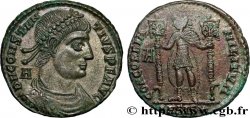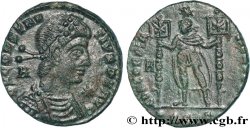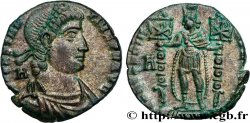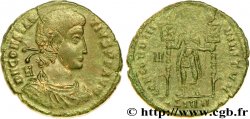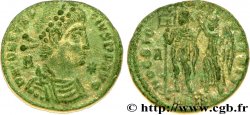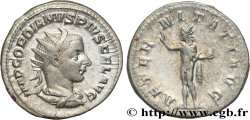v24_0737 - VETRANIO por CONSTANCIO II Maiorina
MONNAIES 24 (2005)
Precio de inicio : 175.00 €
Valoración : 250.00 €
Precio realizado : 205.00 €
Número de ofertas : 2
Oferta más alta : 275.00 €
Precio de inicio : 175.00 €
Valoración : 250.00 €
Precio realizado : 205.00 €
Número de ofertas : 2
Oferta más alta : 275.00 €
Tipo : Maiorina
Fecha: 350
Nombre del taller / ciudad: Savie, Siscia
Metal: cobre
Diámetro: 22 mm
Eje de acuñación: 6 h.
Peso: 4,96 g.
Grado de rareza: R1
Officine: 5e
Emission: 1re
Comentarios sobre el estado de conservación:
Exemplaire de qualité exceptionnelle avec un portrait magnifique. Revers historiquement important. Extraordinaire patine vert olive foncé
N° en los catálogos de referencia :
Anverso
Titulatura del anverso: D N CONSTAN-TIVS P F AVG/ A|*.
Descripción del anverso: Buste diadémé, drapé et cuirassé de Constance II auguste à droite, vu de trois quarts en avant (A'a) ; diadème perlé.
Traducción del anverso: "Dominus Noster Constantius Pius Felix Augustus), (Notre seigneur Constance pieux heureux auguste).
Reverso
Titulatura del reverso: HOC SIG-NO VICTOR ERIS/ A|-/ .ESIS..
Descripción del reverso: L'empereur debout à gauche, vêtu militairement, tenant de la main droite le labarum chrismé et un sceptre transversal de la main gauche, couronné par la Victoire placée derrière lui, tenant une palme de la main gauche.
Traducción del reverso: “Hoc Signo Victor Eris”, (Sous ce signe tu seras vainqueur).
Comentario
Quand Vétranion fut proclamé auguste le 1er mars 350, il le fit à la demande de la sœur de Constance II afin d’empêcher Magnence de s’emparer des Balkans. Vétranion associa Constance dans son monnayage d’ou la présence d’un monnayage important pour l’atelier de Siscia. Poids lourd pour une pièce normalement taillée au 1/72 L. (poids théorique 4,51 g). Il est possible que des flans préparés pour les pièces au 1/60 L. (poids théorique 5,41 g), qui se caractérise par l’absence d’étoile au droit dans le champ à droite, aient été utilisés par erreur, pour les types légers.
When Vetranio was proclaimed Augustus on March 1, 350, he did so at the request of Constantius II's sister to prevent Magnentius from seizing the Balkans. Vetranio involved Constantius in his coinage, hence the presence of a significant coinage for the Siscia mint. Heavy weight for a coin normally cut to 1/72 L. (theoretical weight 4.51 g). It is possible that blanks prepared for coins to 1/60 L. (theoretical weight 5.41 g), which is characterized by the absence of a star on the obverse in the right field, were used by mistake, for the light types
When Vetranio was proclaimed Augustus on March 1, 350, he did so at the request of Constantius II's sister to prevent Magnentius from seizing the Balkans. Vetranio involved Constantius in his coinage, hence the presence of a significant coinage for the Siscia mint. Heavy weight for a coin normally cut to 1/72 L. (theoretical weight 4.51 g). It is possible that blanks prepared for coins to 1/60 L. (theoretical weight 5.41 g), which is characterized by the absence of a star on the obverse in the right field, were used by mistake, for the light types








 Informar de un error
Informar de un error Imprimir la página
Imprimir la página Comparte mi selección
Comparte mi selección Haz una pregunta
Haz una pregunta Consignar / vender
Consignar / vender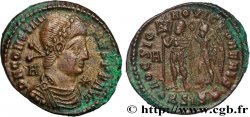
 Descriptivo
Descriptivo